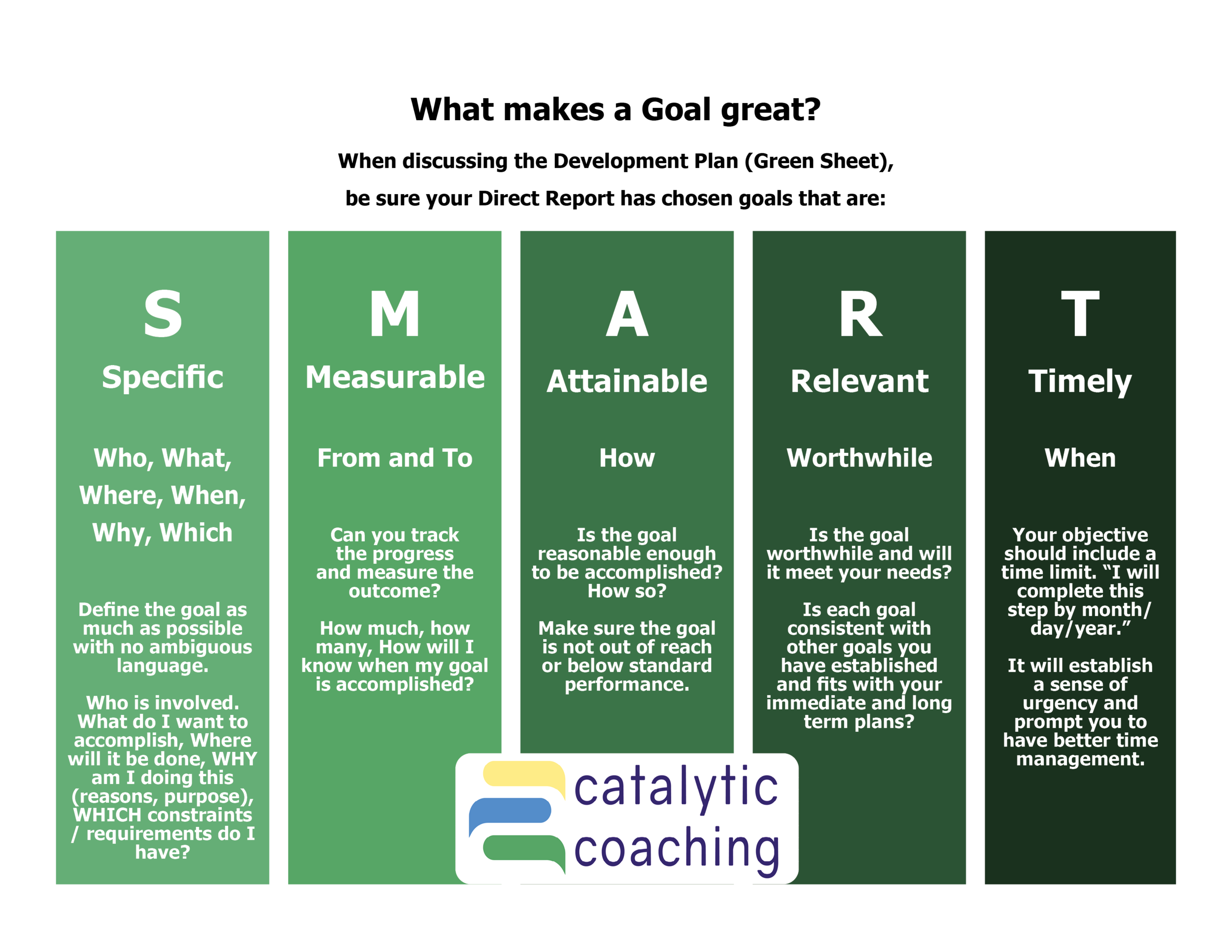Your time is valuable. No one should be wasting it.
We’re all a work in progress. From our personal lives to our professional careers, there is always something we can be doing to improve. Actively pursuing those goals is the only way to get them accomplished.
Through the Catalytic Coaching process, employees identify their Focus Areas with help from their Coach and then craft a Development Plan. It becomes a continuous process that works toward elevating the employee’s efforts and improving the overall company.
Unfortunately, some Coaches get lost along the way and aren’t leveraging those Development Plans to get the most out of everyone’s effort. When the next Coaching cycle comes around, it’s harder to successfully Coach if we’ve dropped the work from before. If the Focus Areas are the real meat of the Coaching process, then the Development Plan and Progress Updates are the knife and fork you need to enjoy it.
How do you get the most out of that Development Plan?
1) Get SMART. The very first thing any Coach must do when looking over the Development Plan an employee has created is to ask if the goals are SMART. In the 15 minutes allocated for that meeting, we’ll want to see each Focus Area supported with multiple objectives that are Specific, Measurable, Attainable, Relevant, and Timely.
2) Block it off. After a Coach wraps up the Development Plan meeting, they should have the employee block off time to follow up. This is the ideal time for progress to be monitored and any bumps in the road to be identified before they become a pothole of a problem. Getting those 15 minute quarterly Progress Update Meetings in the calendar will help make sure they happen. Asking a team member to take responsibility for scheduling them puts them in charge of their Development Plan’s success.
3) Log the time. What’s the point of making the effort if it’s not being tracked? Have employees mark their progress for each goal.
That is made extremely easy through the Catalytic Coaching Online software powered by Energage. They can indicate if they are progressing, completed, delayed, or cannot continue and input details accordingly. This vital information is stored securely and software administrators can pull reports on individuals, departments, or the entire organization as needed for tracking.
4) Don’t be afraid to ask. When in doubt, there’s no reason for a Coach to struggle alone. Every organization that is getting the most out of their Coaching efforts has invested in a certified Coach2. These Coach of Coaches have attended either the old Catalytic Coaching Course or the newly redesigned Mastery Program. Through instruction led by Gary Markle and his team coupled with in-depth exercises that focus on practical applications of Catalytic Coaching methods and best practices, they are empowered to guide the Coaching process.
Bonus Tip for Virtual Coaching: For those that are working from home or out of the office, Coaching meetings can still happen.
Set them up via Zoom or other virtual meeting platform.
Be sure both the Coach and team member are camera ready. Body language and facial expressions are still an important part of the input you get while Coaching.
Share sheets easily by logging into your Catalytic Coaching Online software account, choosing the appropriate sheet for the meeting, and sharing the screen.
Submit sheets after the meeting to allow for any changes that may have come up in the meeting.
If your organization doesn’t have a Coach2 or they’re in need of additional Coach2s, registration is open for the final Catalytic Coaching Mastery Program of 2020. The session starts November 2nd.
Even though it’s virtual, enrollment is limited to allow each attendee the opportunity for individual coaching from Gary and his team.





